2019年译林牛津版初中英语八年级上册Unit 1-8优质课教案
牛津译林版英语八年级上册Unit1Reading2优秀教学案例
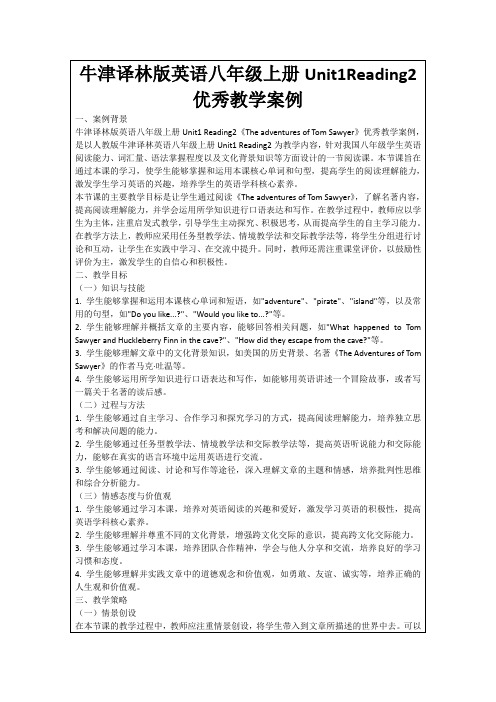
3. 学生能够通过学习本课,培养团队合作精神,学会与他人分享和交流,培养良好的学习习惯和态度。
4. 学生能够理解并实践文章中的道德观念和价值观,如勇敢、友谊、诚实等,培养正确的人生观和价值观。
三、教学策略
(一)情景创设
(三)学生小组讨论
在学生小组讨论阶段,教师可以将学生分成若干小组,让他们在小组内进行讨论和交流。教师可以设计一些问题,引导学生深入理解文章的主题和情感,如"What do you think of Tom Sawyer as a character?"、"What can we learn from his adventures?"等。通过小组讨论,学生能够培养团队合作精神,提高他们的语言表达能力和交际能力。
(四)总结归纳
在总结归纳阶段,教师应引导学生回顾本节课的学习内容,帮助他们梳理和归纳文章的主要观点和情感。教师可以邀请学生分享他们在小组讨论中的观点和感受,进而引导学生总结出文章的主题和价值观。通过总结归纳,学生能够加深对文章内容的理解和记忆。
(五)作业小结
在作业小结阶段,教师应布置相关的作业,让学生巩固本节课所学知识。作业可以包括:1. 完成一份关于名著《The Adventures of Tom Sawyer》的读后感写作,让学生运用所学知识进行口语表达3. 搜集一些关于马克·吐温的资料,让学生深入了解这位作家。通过作业小结,学生能够巩固所学知识,提高他们的学习效果。
(二)讲授新知
在讲授新知阶段,教师可以采用直接法,向学生介绍本节课的主要内容和目标。在阅读过程中,教师应引导学生关注文章的关键词汇和短语,例如"adventure"、"pirate"、"island"等,以及常用的句型,如"Do you like...?"、"Would you like to...?"等。同时,教师还可以通过提问的方式,帮助学生理解文章中的文化背景知识,如美国的历史背景、名著《The Adventures of Tom Sawyer》的作者马克·吐温等。
最新牛津译林初中八年级英语上册 Unit 1-8教案
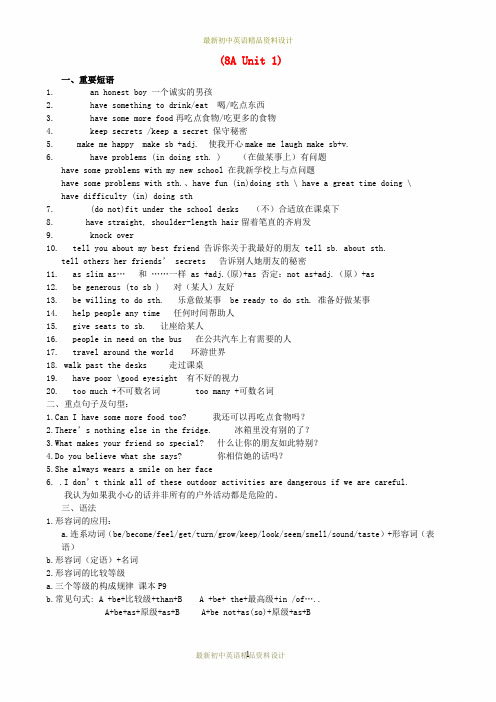
(8A Unit 1)一、重要短语1. an honest boy 一个诚实的男孩2. have something to drink/eat 喝/吃点东西3. have some more food再吃点食物/吃更多的食物4. keep secrets /keep a secret 保守秘密5. make me happy make sb +adj. 使我开心make me laugh make sb+v.6. have problems (in doing sth. ) (在做某事上)有问题have some problems with my new school 在我新学校上与点问题have some problems with sth.、have fun (in)doing sth \ have a great time doing \ have difficulty (in) doing sth7. (do not)fit under the school desks (不)合适放在课桌下8. have straight, shoulder-length hair留着笔直的齐肩发9. knock over10. tell you about my best friend 告诉你关于我最好的朋友 tell sb. about sth.tell others her friends’ secrets 告诉别人她朋友的秘密11. as slim as… 和……一样 as +adj.(原)+as 否定:not as+adj.(原)+as12. be generous (to sb ) 对(某人)友好13. be willing to do sth. 乐意做某事 be ready to do sth. 准备好做某事14. help people any time 任何时间帮助人15. give seats to sb. 让座给某人16. people in need on the bus 在公共汽车上有需要的人17. travel around the world 环游世界18. walk past the desks 走过课桌19. have poor \good eyesight 有不好的视力20. too much +不可数名词 too many +可数名词二、重点句子及句型:1.Can I have some more food too? 我还可以再吃点食物吗?2.There’s nothing else in the fridge. 冰箱里没有别的了?3.What makes your friend so special? 什么让你的朋友如此特别?4.Do you believe what she says? 你相信她的话吗?5.She always wears a smile on her face6. .I don’t think all of these outdoor activities are dangerous if we are careful.我认为如果我小心的话并非所有的户外活动都是危险的。
牛津译林版八年级上Unit1_Friends(第1课时)教案

B. tell
C. talk
D. speak
( )2. ---Which word can’t describe (描述) appearance(外貌)? ---___________.
A. Helpful
B. Beautiful
C. Pretty
D.Good-looking
( )3. ---Where _____ will you go, children?
Teach "sad", "believe", "honest" and "joy".
Ss complete Part A, P7 and report individually.
4. T explains some language points.
Step 4 Presentation
1. T: How old is your best friend? What about you?
过程与方法:
在教授本课时中可以采用任务型教学,利用师生对话,学生小组活动对本单元涉及到有关朋友间品质的单词与词组进行有效教学与巩固练习。
情感态度与价值观:
Let the students talk about their friends happily.
教学重点难点
some more what about= how about nothing else make sb. +形容词
something to drink/eat
numbers + more else
教学活动内容
活动组织过程
改笔
Step1 Warm-up
【牛津译林版】八年级上Unit1第1课时教案讲解分析习题设计

Unit 1 FriendsPeriod I: Comic strip & Welcome to the unit(第一课时)第一部分教案设计教学内容Comic strip & Welcome to the unit(第6~7页),通过两只小狗Eddie和Hobo的对话,引出朋友的话题。
教材分析Comic strip &Welcome to the unit是本单元的第一课时,主要是激发学生兴趣,通过Eddie和Hobo两只小狗之间的对话,引出本单元的学习重点。
掌握相关的描写朋友的重要词汇和两个重要句式:“Maybe we can share it.”和“Can I have something to drink?"。
教学目标基础知识掌握词汇:honest, yourself, humorous,make,joke,secret,magazine,polite,trust,truethirsty, care,good-looking,tidy,lie词组:some more food, keep a secre,t care about, be ready to do sth, tell lies/funny jokesmake sb happy, tell him/her everything about yourself, have problems句型:Can I have something to drink?What about some milk?Can I have some more food?Maybe we can share it.What makes good friends, Amy?基本技能1.掌握本课出现的重点语言点。
2.学习用适当的词描述人的外貌和性格特点。
3.能简单描述好朋友的优秀品质。
综合素质让学生学习用适当的词描述人的外貌和性格特点。
2019年译林牛津版初中英语八年级上册Unit 1 Friends Reading 2优质课教案
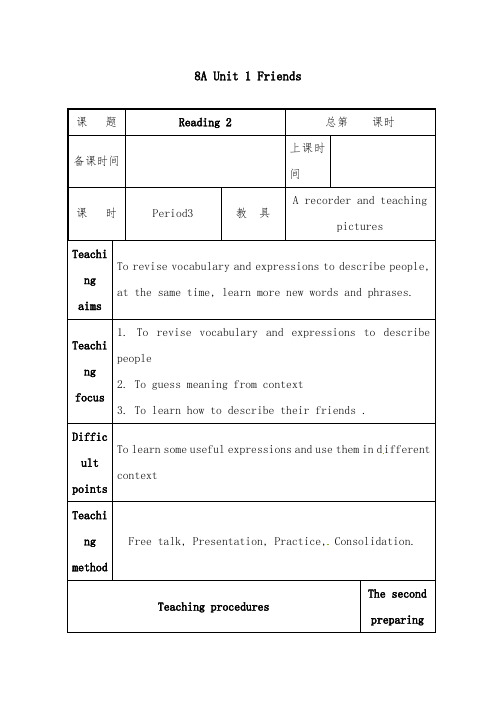
Do you have such a good friend in y ou class, or around you? Please vote for him or her, and tell us your reason. (talk about qualities)
2. Find out their photos according to Mr Zhou’s description.
3. Mr Zhou is writing some notes about them. Is h e right?
4. Voting
Suppose you are going to vote for the best friend among these three students, what is your choice? Why?
Step 4 Langu age points
1.T: now let’s look at some useful expressions in the passages.
Give Ss some phrases for them to translate:
与…一样苗条as slim as乐于做某事be willing to do sth.
(3)她从不说任何人的坏话.She never ____________ about______.
(4)她总是帮我学英语.Sh e always ______ me _______ English.
(5) Jim是一个慷慨大方的人,他总是乐于助人.
(6) Betty长大后想周游世界.
3 .Correct the mistakes
牛津译林版八年级英语上册全套优质教案汇总

牛津译林版八年级英语上册全套优质教案汇总一、教学内容1. Unit 1 FriendsReading: Best friendsVocabulary: New words and expressions related to friendshipGrammar: Comparative forms and superlative forms of adjectives2. Unit 2 School lifeReading: My school lifeVocabulary: New words and expressions related to school lifeGrammar: Present continuous tense3. Unit 3 A day outReading: A visit to the Great WallVocabulary: New words and expressions related to travel and sightseeingGrammar: Past simple tense4. Unit 4 Wild animalsReading: Giants of the oceanVocabulary: New words and expressions related to wild animalsGrammar: Future simple tense二、教学目标1. 能够理解并运用所学的词汇和语法知识进行日常交流。
2. 能够通过阅读文章,提取关键信息并理解文章大意。
3. 培养学生的英语思维能力,提高他们的听说读写综合运用能力。
三、教学难点与重点1. 教学难点:正确运用比较级和最高级形式描述人物和事物。
掌握现在进行时、一般过去时和一般将来时的用法。
2. 教学重点:培养学生运用目标词汇和语法进行情景对话和写作的能力。
四、教具与学具准备1. 教具:教材投影仪音频播放设备2. 学具:课本练习册笔记本五、教学过程1. 导入:通过展示与单元主题相关的图片或视频,引发学生的兴趣和思考。
牛津译林版八年级英语上册全套教案汇总

牛津译林版八年级英语上册全套教案汇总一、教学内容1. Unit 1 Friends:描述友谊的重要性,学会如何描述朋友的特点,了解朋友的兴趣爱好。
2. Unit 2 School life:谈论学校生活,了解不同国家的学校制度,学会用英语表达对学校的看法。
3. Unit 3 A day out:学会描述一次外出活动,用英语进行方位描述,表达对景点的喜好。
4. Unit 4 Do it yourself:介绍手工艺制作过程,学会使用祈使句和说明性语言。
5. Unit 5 Wild animals:了解野生动物,学会用英语描述动物的特点和习性。
6. Unit 6 Birdwatching:介绍观鸟活动,学会描述鸟类的特征,表达对观鸟的喜好。
7. Unit 7 Seasons:描述四季变化,学会用英语表达天气情况和活动安排。
8. Unit 8 Natural disasters:了解自然灾害,学会用英语描述灾害现象和防护措施。
二、教学目标2. 使学生掌握本册教材中的重点词汇、短语和语法知识,并能灵活运用。
3. 培养学生的跨文化交际意识,提高实际运用英语进行交流的能力。
三、教学难点与重点1. 教学难点:词汇的拓展运用、语法知识点的理解、口语表达能力的提升。
2. 教学重点:教材各章节的核心词汇、短语、句型及语法结构。
四、教具与学具准备1. 教具:多媒体设备、黑板、教学卡片等。
2. 学具:教材、笔记本、练习本、彩色笔等。
五、教学过程1. 实践情景引入:通过图片、视频等方式,让学生身临其境地感受各个单元的主题,激发学习兴趣。
2. 例题讲解:针对每个单元的重点知识,设计典型例题,引导学生分析和解答。
3. 随堂练习:设置适量练习题,巩固所学知识,提高学生的实际运用能力。
4. 互动环节:组织学生进行小组讨论、角色扮演等活动,培养学生的口语表达和团队协作能力。
六、板书设计1. 每个单元的核心词汇、短语和句型。
2. 语法知识点及其例句。
牛津译林版八年级英语上册Unit 1 Reading (I) 示范课教学设计
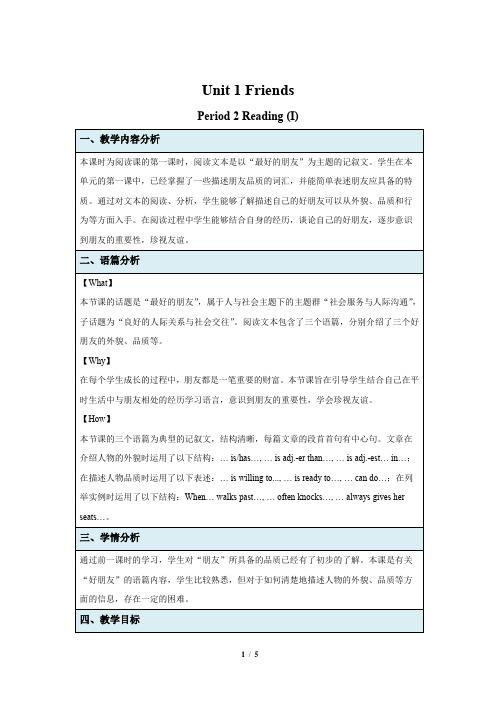
活动层次
学习理解之概括与整合
查看学生的作答情况,了解他们获取阅读语篇关键信息的情况。
环节设计意图:
通过不同的阅读活动,培养学生获取文章大意及关键信息的能力,帮助学生理清文章内容,同时表格的形式能够帮助学生建立框架意识。
训练学生在真实情境中运用目标语言的能力。
环节六:基于语篇,探究主题意义。(4 mins)
教师引导学生思考问题,探究“朋友”的重要性。
教学活动
14. Students discuss the questionwhy they need friends.
活动层次
迁移创新之推理与论证
效果评价
倾听学生的讨论,了解学生对主题意义的理解程度。
环节设计意图:
升华主题,引导学生了解语篇背后所蕴含的情感态度。
作业与拓展
1. Finish the exerciseB1.
2. Review the new words and phrasesthey’ve learnt today.
二、语篇分析
【What】
本节课的话题是“最好的朋友”,属于人与社会主题下的主题群“社会服务与人际沟通”,子话题为“良好的人际关系与社会交往”。阅读文本包含了三个语篇,分别介绍了三个好朋友的外貌、品质等。
【Why】
在每个学生成长的过程中,朋友都是一笔重要的财富。本节课旨在引导学生结合自己在平时生活中与朋友相处的经历学习语言,意识到朋友的重要性,学会珍视友谊。
环节设计意图:
通过看图说话和匹配活动,帮助学生熟悉话题,同时在情境中学习新词,有利于加深学生对新词的理解。通过预测活动,进一步帮助学生了解话题,培养学生读前预测的意识和习惯,有效降低阅读难度。
牛津译林版英语八年级上册Unit1IntegratedskillsSpeakup教学设计
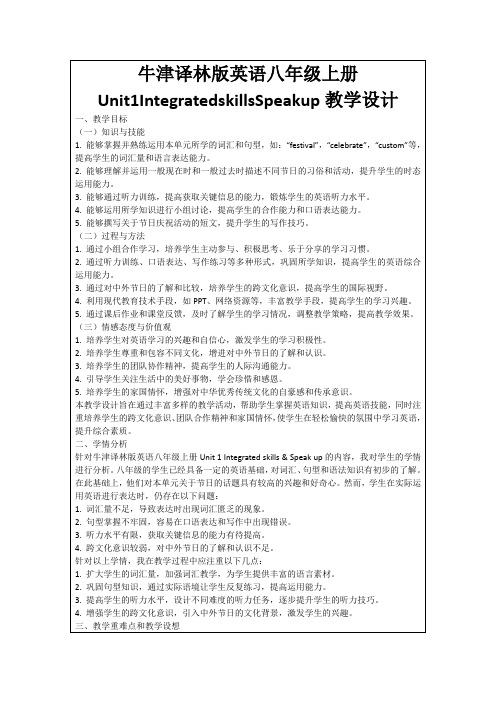
3.培养学生的团队协作精神,提高学生的人际沟通能力。
4.引导学生关注生活中的美好事物,学会珍惜和感恩。
5.培养学生的家国情怀,增强对中华优秀传统文化的自豪感和传承意识。
本教学设计旨在通过丰富多样的教学活动,帮助学生掌握英语知识,提高英语技能,同时注重培养学生的跨文化意识、团队合作精神和家国情怀,使学生在轻松愉快的氛围中学习英语,提升综合素质。
2.互动教学:采用任务型教学法,设计小组讨论、角色扮演等互动环节,鼓励学生主动参与,提高口语表达能力。
3.分层教学:针对不同水平的学生,设计不同难度的听力练习和口语任务,使每个学生都能在原有基础上得到提高。
4.文化渗透:在教学中融入中外节日的文化背景,引导学生了解和尊重不同文化,提高跨文化交际能力。
2.学生完成练习后,教师及时反馈,解答学生的疑问,纠正错误。
3.教师设计情景对话,让学生两人一组进行角色扮演,练习在实际情境中运用所学知识。
4.针对课堂练习,教师进行评价,鼓励学生继续努力,提高英语水平。
(五)总结归纳
1.教师引导学生回顾本节课所学的内容,总结节日的词汇、句型和时态用法。
2.学生分享学习收获,如:“I learned how to describe festival customs using different tenses...”
5.激励评价:采用积极评价策略,关注学生的进步,鼓励学生自我反思,提高学习自信心。
6.教学策略:
a.利用多媒体手段,如PPT、视频等,丰富教学资源,提高学生的学习兴趣。
b.采用“自主学习+合作学习”的模式,培养学生主动探究、合作解决问题的能力。
c.定期进行课堂反馈,了解学生的学习需求,及时调整教学方法和进度。
初中英语八年级上册(牛津译林版)Unit1Reading教学设计

-以Reading部分为蓝本,进行仿写练习,引导学生运用所学词汇和句型。
-提供写作框架,指导学生进行有针对性的写作训练。
-开展互评和自评活动,让学生在评价中互相学习,提高写作水平。
4.激发学习兴趣,培养合作精神和跨文化意识:
-创设有趣、富有挑战性的课堂活动,激发学生的学习兴趣。
-鼓励学生参与小组合作,培养团队协作能力和跨文化沟通能力。
2.阅读理解:选取一篇与单元主题相关的短文,设计5-10道阅读理解题目,要求学生完成并写出答案解析,以检验学生对阅读策略的运用和文章理解能力。
3.写作任务:根据Reading部分的内容,仿写一篇介绍人物的短文,运用所学的词汇和句型,注意句子结构和用词的丰富性。要求不少于80词。
4.小组作业:分组讨论,选择一个感兴趣的人物,收集相关信息,并以海报或PPT的形式呈现出来。在下一堂课上,每组进行展示,分享他们所了解的人物特点、成就等。
2.重点:培养学生的阅读理解能力和写作能力。
难点:如何引导学生从文章中捕捉关键信息,并进行有效整合,运用到写作中。
3.重点:激发学生的学习兴趣,培养合作精神和跨文化意识。
难点:如何针对不同学生的学习需求和特点,设计具有针对性的教学活动。
(二)教学设想
1.针对词汇和语法知识的教学:
-利用图片、实物等教学辅助手段,帮助学生形象记忆词汇。
5.学生在情感态度上,对英语学习存在一定程度的分化,部分学生对英语学习兴趣浓厚,积极参与课堂活动;另一部分学生则表现较为被动,缺乏自信。
三、教学重难点和教学设想
(一)教学重难点
1.重点:本章节的核心词汇和短语,以及一般现在时和一般过去时的运用。
难点:如何让学生在实际语境中灵活运用所学的词汇和语法知识进行表达和交流。
牛津译林版8上Unit 1 welcome to the unit教案
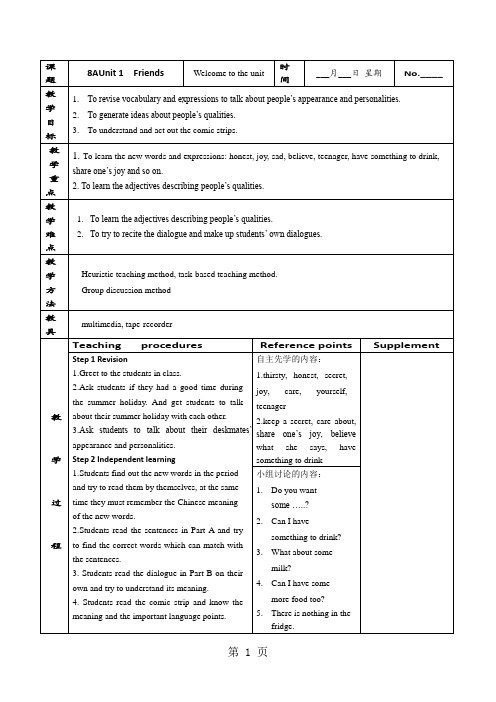
小组讨论的内容:
1.Do you want some …..?
2.Can I have something to drink?
3.To understand and act out the comic strips.
教
学
重
点
1.To learn the new words and expressions: honest, joy, sad, believe, teenager, have something to drink, share one’s joy and so on.
3.做游戏练习描述别人。
一个学生用英语描述他/她的同学,让其他学生猜
检测的内容:
1. Is there ____ behind the tree?
Asomething unusual Banything unusual
Cunusual something2.It is a s______ between you and me. Don’t tell others.
教
学
方
法
Heuristic teaching method, task-based teaching method.
Group discussion method
教
具
multimedia, tape-recorder
教
学
过
程
Teaching procedures
Reference points
牛津译林版英语八年级上册Unit1教学设计

3.丰富课堂活动,引入跨文化交际元素,让学生在了解不同节日文化的同时,提高他们的交际能力。
4.关注学生的个体差异,给予每个学生充分的鼓励和支持,提高他们在课堂中的参与度。
三、教学重难点和教学设想
(一)教学重难点
1.重点:本章节的核心词汇和短语,如festival, celebrate, traditional, custom等;一般现在时和一般过去时的用法;目标句型的运用。
b. How do people celebrate this festival in different countries?
c. What does this festival mean to you?
4.教师巡回指导,给予每组建议和鼓励,提高学生的讨论效果。
(四)课堂练习
1.教师设计一系列练习题,包括词汇填空、语法改错、句型转换等,让学生巩固所学知识。
难点:在实际语境中灵活运用所学词汇和语法结构进行表达;跨文化交际能力的培养。
2.重点:通过本章节的学习,让学生了解世界各地的节日文化,提高他们的跨文化意识。
难点:如何引导学生将所学知识与文化背景相结合,进行深入的思考和表达。
(二)教学设想
1.创设情境,激发兴趣:以学生熟悉的节日为切入点,通过图片、视频等多媒体资源,让学生了解世界各地的节日庆典,激发他们对本章节内容的学习兴趣。
(三)学生小组讨论
1.教师将学生分成小组,每组选择一个节日进行深入研究,查找资料、讨论节日的起、习俗、意义等。
2.各小组展示他们的研究成果,用英语介绍所研究的节日,并与其他小组分享。
3.学生在小组内用目标语言讨论以下问题:
牛津译林版英语八年级上册Unit1Reading1教学设计
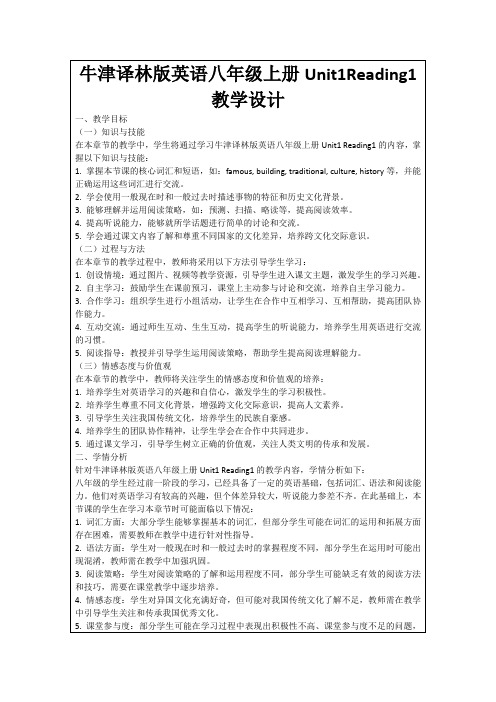
(二)讲授新知
1.教学活动设计:
-通过阅读课文,让学生了解课文主要内容,学习本节课的核心词汇和短语。
-讲解一般现在时和一般过去时的用法,通过例句和情境,让学生在实际语境中体会两种时态的区别。
-引导学生运用阅读策略,如预测、扫描、略读等,提高阅读效率。
2.教学目标:
-让学生掌握本节课的核心词汇和短语。
-帮助学生理解并运用一般现在时和一般过去时描述事物的特征和历史文化背景。
-提高学生的阅读策略运用能力。
(三)学生小组讨论
1.教学活动设计:
-将学生分成小组,针对课文内容进行讨论,分享自己了解到的各国文化及著名建筑。
-每个小组选出一个代表进行汇报,展示小组讨论成果。
2.教学目标:
-培养学生的合作学习能力和口语表达能力。
1.词汇练习:请学生完成课后词汇填空练习,要求正确运用本节课所学核心词汇和短语。
2.语法练习:设计一般现在时和一般过去时的语法练习题,让学生在实际语境中运用两种时态,提高语法运用能力。
3.阅读理解:布置一篇关于介绍世界著名建筑的阅读文章,要求学生运用阅读策略,提高阅读效率,并完成相关阅读理解题目。
4.写作任务:请学生选取一个自己感兴趣的著名建筑,用英语写一篇短文,描述该建筑的特点、历史背景和文化意义,不少于80词。
5.口语作业:鼓励学生课后与家长或朋友进行英语对话,分享本节课所学内容,提高口语表达能力。
6.拓展阅读:推荐学生阅读关于世界各国的文化、风俗和著名建筑的书籍或文章,拓宽知识面,增强跨文化交际意识。
作业布置注意事项:
1.作业难度适中,既要巩固所学知识,又要激发学生的学习兴趣。
2.作业量适中,避免给学生造成过重的负担,确保学生有足够的时间进行复习和拓展。
牛津译林版八年级英语上册unit1第8课时教学案(无答案)

牛津译林版八年级英语上册讲学稿(审校五中)课题:8A unit1 Friends study skills Period 8 主备人:一、课前预习导学(一)学习目标1. 掌握阅读技巧,找出文章要点和关键词,提高阅读速度。
1.进行写作训练,学会制作文章摘记,为写作做好准备。
写作时注意篇章布局,层次分明,条理清晰。
2.学会猜测词义,并在头脑中想象。
预习导学:3.阅读文章时注意6个“Wh-”和1个“H”,并能找出关键词。
4.重点词汇:reader, magazine, move, advice, in the future5.语言点:①②③6.培养良好的学习习惯,提倡科学的学习方法.二、课堂合作探究课堂学习:导入新课:阅读文章时想知道什么?启发学生得出六个“wh-”和一个“H-”。
7.阅读理解“Looking for main points and keywords”8.阅读理解语境,听老师读并回答问题:Who is Cindy? Why is Cindy unhappy? What is Cindy’s problem?9.介绍阅读技巧,记住六个“Wh-”和一个“H-”。
10.运用技巧,独立细读课文,划出要点,在集体校对。
再读课文,划出关键词语。
11.分组活动:再看要点和关键词语,回答问题:(1)What is it about? ( It’s about problems with a new school. )(2)Who is it about? ( It’s about a Grade 8 student. )(3)What happened? ( She changed to a new secondary school. She is unhappy,nervous and uncomfortable at the new school. She is always alone. )(4)Where did it happen? ( In Sunshine Town.)(5)When did it happen? ( After changing to the new school.)(6)Why did it happen? ( She doesn’t have friends there and she misses herclassmates in the old school.)三、课内练习巩固Ⅰ. 单项选择:( )1. Do you know our city ---- Nanjing very ________?A. goodB. niceC. wellD. fine( )2. I hope you ________ me some advice.A. to giveB. giveC. will giveD. giving( )3. Do you feel nervous when you answer your ________ questions in class?A. teacher’B. teacher ofC. teachersD. teacher’( )4. After ________ , I began to like talking with my new classmates.A. sometimesB. sometimeC. some timesD. some time( )5. I miss my old classmates very much. Here “miss” means ________ .A. think overB. think aboutC. think ofD. think that( )6. You may call me if you ________ in the future.A. need to helpB. need helpC. will need helpD. will need helps ( )7. So many people are over there. What ________ ?A. happenedB. is happeningC. is happenedD. does it happen四、课后拓展延伸:改错:1. I often get some advices from my teachers. ________2. Did you have any problem with your Chinese when you were in china? _______3. Can you tell me when are we going to have a picnic? ________4. Where will they have the meeting is a problem ? ________5. The height of Zijin Mountain are more than 440m. ________Ⅲ. 汉翻英:1.我是你们杂志的读者。
牛津译林版八年级英语上册Unit1第3课时优秀教学案例

1.设计一系列化规则,激发学生的思维能力和解决问题的能力。
2.鼓励学生提出问题,引导学生通过讨论和合作,共同解决问题,培养学生的批判性思维和问题解决能力。
3.设计一些拓展性问题,引导学生深入思考和探索过去时的运用,激发学生的创新思维和综合运用能力。
1.通过多媒体课件,讲解一般过去时的构成和动词过去式的变化规则,让学生在理解的基础上掌握过去时的运用。
2.用生动的例子和实际语境,解释和展示一般过去时的用法,帮助学生更好地理解和运用过去时。
3.设计一些练习题,让学生现场练习和应用过去时,检查他们的理解和掌握情况。
(三)学生小组讨论
1.设计一系列小组活动,让学生在小组内用过去时描述过去发生的事情,鼓励学生积极参与和合作,提高他们的团队合作能力和语言实践能力。
牛津译林版八年级英语上册Unit1第3课时优秀教学案例
一、案例背景
牛津译林版八年级英语上册Unit1第3课时优秀教学案例,以“一般过去时”为主题,旨在通过真实情境的创设,引导学生掌握过去时的构成和运用,提高他们的语言实践能力。本节课的内容包括一般过去时的构成、动词过去式的变化规则、以及如何运用过去时描述过去发生的事情。在教学过程中,我充分考虑了学生的认知水平,设计了丰富多样的教学活动,以激发学生的学习兴趣,提高他们的参与度。
4.巩固拓展:通过完成一篇小作文,让学生运用过去时描述一个过去的故事,进一步巩固所学知识。
5.总结反馈:对本节课的内容进行总结,对学生的学习情况进行反馈,为后续教学提供参考。
在整个教学过程中,我注重启发式教学,引导学生主动探究、积极互动,使他们在实践中学会运用过去时。同时,我还关注学生的个体差异,给予不同程度的学生个性化的指导和关爱,确保每个学生都能在课堂上获得良好的学习体验。
牛津译林版八年级上英语Unit1集体备课教案(表格式)

牛津译林版八年级上英语Unit1集体备课教案(表格式)课题8A Unit 1 Welcome to this unit 课型New教学目标知识目标:谈论人的外貌个性,学习描述人的单词和表达法。
技能目标:谈论各自的朋友,掌握描述人物相貌和品质的知识。
情感目标:了解并逐步养成好朋友必须具备的优良的品质。
教学重点学会用表示人的品质的单词与词组来描述自己的朋友。
教学难点理解并正确运用与朋友品质相关的单词与词组。
教学过程教师内容备课札记Step1 Warm-upTalk about something happened in the summer holiday.Show the pictures and introduce some places of interestand animals in Australia.Ask the class to enjoy some photos. They took a photowith this famous man--- Batman. He’s a hero and people’s good friend because he helps people in danger. Do youagree? What do you think of him?Step 2 PresentationThere are some more words to describe people. Forexample, we can say Batman is good-looking. But we never say he’s beautiful! We don’t use beautiful to describe a boyor a man. If someone likes to tell funny jokes to makeothers happy, we say he or she is humorous.Teach “good-looking”and “humorous”.Step 3 Practice1. Play a guessing game.2. T: Just now we heard some of the students talk abouttheir best friends. Could you tell me which words are usedmost often? So these are very important qualities of a bestfriend, do you think so? What other qualities are important to you?Sentences may be used:I think my good friend should be very … because…I agree. / I don’t agree with you because …It’s q important for a friend to be …? Do you think so?I don’t think my good friend must be very …3. T: Why do you think he/she is your best friend? Whatmakes him/her so special to you? Can you talk to him/herabout anything? Do you talk to him/her when you haveproblems? Do you believe what he/she says? When you are happy or sad, do you talk to him/her?Teach “sad”, “believe”, “honest” and “joy”.Step 4 PresentationT explains some language points.1. T: How old is your best friend? What about you?So you are teenagers. We call children between 13 and 19 teenagers.Teach “teenager”.We have a good friend, Eddie. Is he a teenager?2. Who’s Eddie’s good friend? Why?Play the tape of the Comic strip and Ss try to find out the answer to the question.(Hobo is Eddie’s good friend because they always share things with each other.)Ask the students to read the Comic strip and answer the questions:(1) What does Eddie give Hobo?(2) What does Hobo want?(3) Do you think Eddie is a true friend? Why?T explains some language points.Step 5 SummarizeDiscuss: Who do you like better as a friend, Eddie or Hobo? Why?A model dialogue:A: Who’s your good friend?B: …A: What’s he/s he like?B: …A: What do you think of your friend?B: …A: What makes him/her so special to you?B: … Can you tell me something about your good friend? T: Today we have learned some important qualities about a good friend. It seems that we all think appearance is not so important, but a friend should be helpful and honest. And I hope everyone can be like that and you will have more friends.Step 6 Homework1. Describe a good friend of yours with the words and phrases learnt in this lesson.2. Finish the Workbook exercises.板书设计教学反思课题8A Unit 1 Friends Reading (1) 课型New教学目标知识目标:进一步学习用形容词来描述朋友的外貌和个性。
牛津译林版八年级英语上册全册教学课件

牛津译林版八年级英语上册全册教学课件Unit 1Friends welcome to the unitObjectivesTo master (掌握) the words that talk about a friend’s qualities To think about what qualities are important in a good friend单词回顾学生早读时已预习过本单元单词,可利用几分钟时间带学生快速回顾温习。
对单词的熟练度越高,阅读的速率也越高。
thirstyhonestsecret keep a secretjoycare care about adj. 口渴的adj. 诚实的;正直的n. 秘密保守秘密n. 欢乐,高兴;乐趣vi. & vt. 关心,关注,在意关心,关怀Words & phrases reviewyourselfteenagermagazine good-looking humorouspolite pron. 你自己n. (13至19岁的)青少年n. 杂志adj. 好看的,漂亮的adj. 幽默的adj. 礼貌的Words reviewtidy make trustlie joke trueadj. 爱整洁的,整洁的linking v. 成为;适合vt. 信任n. 谎言n. 玩笑adj. 确实的;的确Words reviewListenWe have a good friend, Eddie. He is funny and can always make us happy. Who is Eddie’s good friend? Why do you think so? Let’s listen to their conversation.Comic Strip:1. Hobo is hungry. What does Eddie give him?2. Does Hobo want to have something to drink? What is it?3. What else does Hobo want?4. Is there anything else in the fridge?QuestionsEddie gives him a cake. Yes, he wants to have something to drink. It is milk. He wants to have some more food.No, there’s nothing in the fridge.Role playSuppose you are Hobo and your partner is Eddie, make a dialogue by yourselves. Using the dialogue in the text as a model. Will Eddie share his pizza with Hobo? Go on with this dialogue and make it more interesting.TalkAre Eddie and Hobo good friends? Who do you like more?Qualities of a good friendYou all have good friends. What are your friends like?Are your friends helpful?honest?clean and tidy?good-looking?clever?kind / polite?…honest helpfulfriendlypolite good-lookinginterestinghumoroustidyTalkIt’s important for you to have a good friend. What qualities are important in a good friend? What makes your friend special? Please have a talk in pairs, using the following sentences as a model.It is important to be … My friend is …To be … is very important.Good friends should be …I think a friend should be humorous.A good friend is someone who makes me happy.I want anhonest man tobe my friend. Please look at the following answers.helpful honest keep a secret makes me happy shares my joy e c a bd a. Does he/she care about you when you are sad?b. Do you talk to him/ herwhen you are happy?c. Can you tell him/hereverything about yourself?d. Is he/she ready to helpwhen you have problems?e. Do you believe whathe/she says?Match the qualities on the left with the questions on the right.ActivityWho is your friend?Please say hello to him/her loudly, and tell him or her why he/she is your friend.What are the important qualities of a good friend?kindhelpfulbeautiful good-looking politeclever strong richmusical friendly honest funny slim tidy …Work in pairs and talk about what qualities you think are important. Use the conversation below as a model.Daniel: What make good friends, Amy?Amy: Well, good friends should be honest. You can trust them because they never tell lies. Daniel: Yes, that’s very important. I think good friends should be interesting too. They can alsotell you funny jokes.Amy: Yes, that’s true. I also think good friends should be helpful.Daniel: I agree.Listen again and complete the sentences.Amy thinks good friends should be ______ and _______.Daniel thinks good friends should be __________.Amy and Daniel ______ _____ eachother’s opinion.honest helpful interesting agree with1.Can I have something to drink? have something to drink 喝点东西If you are thirsty, have something to drink.如果你渴了就喝点什么吧。
初中英语牛津译林版八年级上册Unit8《Reading1An earthquake》优质课教案获奖教案公开课教师面试试讲教案
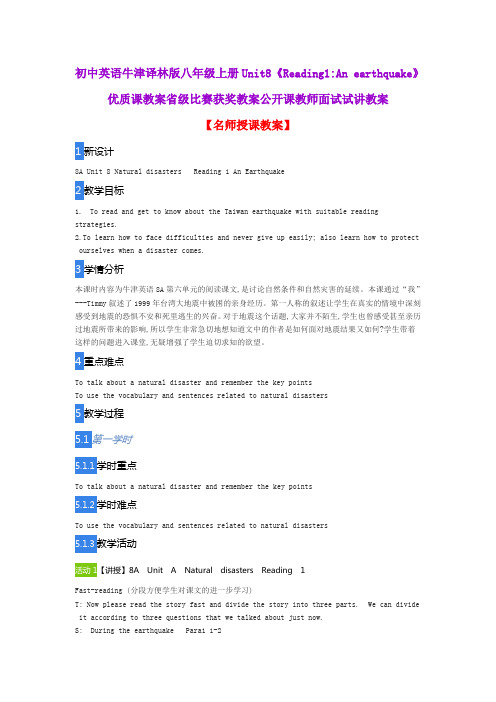
初中英语牛津译林版八年级上册Unit8《Reading1:An earthquake》优质课教案省级比赛获奖教案公开课教师面试试讲教案【名师授课教案】1新设计8A Unit 8 Natural disasters Reading 1 An Earthquake2教学目标1.To read and get to know about the Taiwan earthquake with suitable reading strategies.2.To learn how to face difficulties and never give up easily; also learn how to protect ourselves when a disaster comes.3学情分析本课时内容为牛津英语8A第六单元的阅读课文,是讨论自然条件和自然灾害的延续。
本课通过“我”---Timmy叙述了1999年台湾大地震中被困的亲身经历。
第一人称的叙述让学生在真实的情境中深刻感受到地震的恐惧不安和死里逃生的兴奋。
对于地震这个话题,大家并不陌生,学生也曾感受甚至亲历过地震所带来的影响,所以学生非常急切地想知道文中的作者是如何面对地震结果又如何?学生带着这样的问题进入课堂,无疑增强了学生迫切求知的欲望。
4重点难点To talk about a natural disaster and remember the key pointsTo use the vocabulary and sentences related to natural disasters5教学过程5.1第一学时学时重点To talk about a natural disaster and remember the key points学时难点To use the vocabulary and sentences related to natural disasters教学活动1【讲授】8A Unit A Natural disasters Reading 1Fast-reading (分段方便学生对课文的进一步学习)T: Now please read the story fast and divide the story into three parts. We can divide it according to three questions that we talked about just now.S: During the earthquake Para1 1-2。
牛津译林版英语八年级上册Unit1优秀教学案例

(一)知识与技能
1.学生能够正确运用一般现在时表达自己的日常作息、习惯以及描述他人的特点。
2.学生掌握一般现在时的构成听懂、会说、会读、会写一般现在时的句子,提高英语语言表达能力。
(二)过程与方法
1.通过观察、思考、实践和交流,让学生在具体情境中感知、理解和运用一般现在时。
(二)问题导向
1.教师提出具有启发性的问题,引导学生思考、讨论和探究一般现在时的用法和动词变化规则。
2.设计一系列由浅入深的问题,帮助学生巩固一般现在时的知识点,提高学生的思维能力。
3.鼓励学生提问,充分调动学生的积极性,培养学生的自主学习能力。
(三)小组合作
1.教师将学生分成若干小组,组织学生进行合作学习,共同完成任务。
1.教师引导学生总结一般现在时的结构、用法和动词变化规则。
2.学生通过归纳总结,加深对一般现在时的理解。
3.教师对本节课的主要内容进行总结,强调一般现在时的关键知识点。
(五)作业小结
1.教师布置作业,要求学生运用一般现在时描述自己的日常作息、习惯和他人特点。
2.学生完成作业,教师及时批改,给予反馈和鼓励。
作为一名特级教师,应充分运用情景创设、问题导向、小组合作和反思与评价等教学策略,关注学生的知识与技能、过程与方法以及情感态度与价值观的培养。通过本节课的教学,使学生在掌握一般现在时的同时,提高英语综合素质,为今后的学习和生活奠定坚实基础。
四、教学内容与过程
(一)导入新课
1.教师通过展示一幅描绘学生日常生活的图片,引导学生观察并思考:“请大家看看图片中的同学们在做什么?他们是在描述现在的事情还是在描述经常发生的事情?”
1.情境创设贴近生活:本节课通过展示学生生活的图片和视频,引导学生运用一般现在时描述日常作息和他人特点。这种情境创设贴近学生生活,使学生在具体情境中感知、理解和运用一般现在时,提高学生的语言实践能力。
- 1、下载文档前请自行甄别文档内容的完整性,平台不提供额外的编辑、内容补充、找答案等附加服务。
- 2、"仅部分预览"的文档,不可在线预览部分如存在完整性等问题,可反馈申请退款(可完整预览的文档不适用该条件!)。
- 3、如文档侵犯您的权益,请联系客服反馈,我们会尽快为您处理(人工客服工作时间:9:00-18:30)。
(8A Unit 1)一、重要短语1. an honest boy 一个诚实的男孩2. have something to drink/eat 喝/吃点东西3. have some more food再吃点食物/吃更多的食物4. keep secrets /keep a secret 保守秘密5. make me happy make sb +adj. 使我开心make me laugh make sb+v.6. have problems (in doing sth. ) (在做某事上)有问题have some problems with my new school 在我新学校上与点问题have some problems with sth.、have fun (in)doing sth \ have a great time doing \have difficulty (in) doing sth7. (do not)fit under the school desks (不)合适放在课桌下8. have straight, shoulder-length hair留着笔直的齐肩发9. knock over10. tell you about my best friend 告诉你关于我最好的朋友 tell sb. aboutsth.tell others her friends’ secrets 告诉别人她朋友的秘密11. as slim as… 和……一样 as +adj.(原)+as 否定:not as+adj.(原)+as12. be generous (to sb ) 对(某人)友好13. be willing to do sth. 乐意做某事 be ready to do sth. 准备好做某事14. help people any time 任何时间帮助人15. give seats to sb. 让座给某人16. people in need on the bus 在公共汽车上有需要的人17. travel around the world 环游世界18. walk past the desks 走过课桌19. have poor \good eyesight 有不好的视力20. too much +不可数名词 too many +可数名词二、重点句子及句型:1.Can I have some more food too? 我还可以再吃点食物吗?2.There’s nothing else in the fridge. 冰箱里没有别的了?3.What makes your friend so special? 什么让你的朋友如此特别?4.Do you believe what she says? 你相信她的话吗?5.She always wears a smile on her face6. .I don’t think all of these outdoor activities are dangerous if we arecareful.我认为如果我小心的话并非所有的户外活动都是危险的。
三、语法1.形容词的应用:a.连系动词(be/become/feel/get/turn/grow/keep/look/seem/smell/sound/taste)+形容词(表语)b.形容词(定语)+名词2.形容词的比较等级a.三个等级的构成规律课本P9b.常见句式: A +be+比较级+than+B A +be+ the+最高级+in /of…..A+be+as+原级+as+B A+be not+as(so)+原级+as+B初二英语复习教案(8A Unit 2)一、重要短语1.你理想中的学校your ideal school2.全世界all over the world/ around the world/the whole world3.中学high/ secondary school4.一楼first/ ground floor5.美式足球American football6.说不同的语言speak different languages7.一门有用的语言a useful language8.在八年级in Year 8/ in Grade 8 / in 8th grade9.一所混合学校a mixed school10.家政课Home Economics11.为我自己做事情do things for myself12.在每节课快结束时near the end of each class13. 也as well14.一所英国学校a British school15.一所美国学校an American school16.做健康的美味的食物cook healthy and tasty meals17.学习怎样做饭、缝衣服learn how to cook and sew18.把家里的书和杂志带进bring in books and magazines from home19在午饭期间during lunchtime在午饭时间at lunchtime20.上驾驶课have driving lessons21.开车送我上学drive me to school / take me to school by car22.做某事花费时间spend...doing / spend ------ on sth..23.练习做某事practice doing24.做…很高兴have a good time doing/have fun doing/ enjoy oneself doing25. 一位挚友a close friend26.在搭档俱乐部in the Buddy Club27.在今年的阅读周期间during this year’s Reading Week28.一个美国女孩写的文章an article(written) by a girl from the USA29.一名12年级的毕业生a senior in 12th grade30.在16岁时at 16/ at age 16/ at the age of 1631.有空闲时间have free time32.对------全面了解learn all about全面了解我的新学校learn all about my new school33.在家庭作业方面帮助我help me with my homework34.倾听我的问题listen to my problems35.有一种美味have a pleasant taste36.在每节课最后near the end of each class37.和某人谈论某事talk to sb. about sth.38.一种球类运动a kind of ball game39.你所崇敬的人someone you admire40.上电视be on TV41.把……与……相compare … with …42.电脑学课Computer Studies43.过一个长达12周的假期have a 12-week holidayhave 12 weeks off44.休息半年have half a year off45.多远(用于提问距离)how far多久时间(用于提问时间连续多久)how long多久(用于提问每隔多久发生:表频率)how often过多久(时间)how soon46.做早操/ 眼保健操do morning/eye exercises47.步行去上学walk to school / go to school on foot48乘飞机去上海go to Shanghai by plane / take a plane to Shanghai / fly to Shanghai49.乘校车take the school bus50.伤了她的腿hurt her leg51.穿校服wear school uniforms52.吃最少的牛肉eat the least beef53.得最少的分score the fewest points54.和……不同be different from55.和……相同be the same as56.在-------相同/一样be the same + n. + as = as + adj. + as the same size as = as big as57.一起上课have lessons together58.在夏季in the summertime59.在网上聊天chat online/chat on the Internet60.在电话里聊天chat on the phone61.向窗外看look out of the window62.表示惊讶show surprise63.课外活动after-school activities64.有一个小时吃午饭have an hour for lunch65.听流行音乐listen to pop music66.养一只宠物猴get a pet monkey67.搬到加拿大move to Canada68.在周末at weekends69.做…有问题have problems doing sth…方面有问题have problems with sth.70.大量的学生a number of students71.学生的数量the number of students72.暑假时间的长the length of summer holiday73.在学校的一边on one side of the school74.在学校的另一边on the other side of the school75.(两者中)一个---另一个one…the other76.垒球游戏softball game77.参加学校旅行去博物馆或剧院go on a school trip to a museum or a theatre78.加入音乐俱乐部join the Music Club79.呆在医院一个月了stay in hospital f or a month80.能够去做某事be able to do sth.81.半小时的家庭作业half an hour of homework82.系领带wear a tie/ ties83.有许多有用的书的图书馆a big library with lots of useful books84.一个网球场a tennis court85.一个游泳池a swimming pool二、重要句子1. What is school like? It is like watching TV.What is your mother like? She is friendly/tall2. John’s school shirt and Daniel’s school shirt are alike.= John’s school shirt is like Daniel’s school shirt.3. What if it rains or snows? = What shall we do if it rains or snows.4. Amy’s pen is the same color as Kitty’s pen.5. I read an article by a girl from the U.S.A.6. It means someone you admire very much.7. She won’t be able to play basketball for three months.8. What does the word“hero” me an?=what is the meaning of the word“hero”? = what do you mean by the word hero?9. What time does your school day start/finish?10. Sandy is helping him (to)collect information on the Internet.三、比较下面的用法:1. like prep. 像/ alike a. 像的His schoolbag is like mine. His schoolbag and mine are alike. 他的书包和我的很像。
